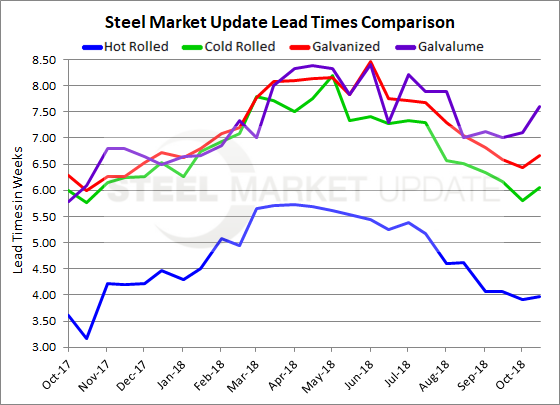SMU Data and Models

SMU Lead Times Move...But Enough to Break the Trend?
Written by John Packard
October 18, 2018
Lead times for most flat rolled steel products ticked up slightly this month, according to returns from Steel Market Update’s latest market trends questionnaire. Could this signal the end of the downtrend? This is an important question considering the domestic steel mills announced price increases just last week.
Lead times for steel delivery are a measure of demand at the mill level—the longer the lead time, the busier the mill. The busier the mill, the less likely they are to negotiate on price. While the data from one two-week period hardly constitutes a trend, it is the first time in a long time that lead times for all products have moved out rather than in. And it would be consistent with the many who believe the market is near a bottom and flat rolled prices are poised to increase. Lead times for hot rolled now average about four weeks, cold rolled about six weeks, galvanized about six and a half weeks, and Galvalume about seven and a half weeks.
The lead times shown come from our flat rolled and plate market trends questionnaire, which is sent to approximately 640 individuals associated with the industry. The lead times are an average of the responses and have no connection with what any individual steel mill may be quoting. To get accurate lead times from any mill, you will need to speak with your representative of that mill. Our lead times are meant to provide an idea of the overall trend so both buyers and sellers can make buying and selling decisions.
Hot rolled lead times now average 3.96 weeks (4 weeks), which is essentially unchanged from early October (3.91 weeks). This year’s longest lead time for hot rolled delivery was 5.73 weeks in April.
Cold rolled orders currently have a lead time of 6.06 weeks, up from 5.80 weeks two weeks ago. Prior to this week’s move, CR lead times had declined steadily from 8.19 weeks in May.
The current lead time for galvanized steel is 6.66 weeks, up from 6.44 weeks early this month. Galvanized lead times this year peaked in June at 8.46 weeks.
At 7.60 weeks, Galvalume lead times are up from 7.11 weeks in the last poll. AZ lead times peaked this year at 8.40 weeks in June.
The movements in lead times we are measuring are relatively small and will need to extend further if the domestic steel mills want to actually collect the increases announced.
Note: These lead times are based on the average from manufacturers and steel service centers who participated in this week’s SMU market trends analysis. Our lead times do not predict what any individual may get from any specific mill supplier. Look to your mill rep for actual lead times. Our lead times are meant only to identify trends and changes in the marketplace. To see an interactive history of our Steel Mill Lead Times data, visit our website here.

John Packard
Read more from John PackardLatest in SMU Data and Models

SMU Survey: Buyers’ Sentiment rebounds from multi-year low
Both of SMU’s Steel Buyers’ Sentiment Indices edged higher this week. Current Sentiment rebounded from a near five-year low, while Future Sentiment rose to a two-month high

SMU flat-rolled market survey results now available
SMU’s latest steel buyers market survey results are now available on our website to all premium members.

SMU Survey: Sheet lead times pull back after early-June blip, plate holds
Following the uptick seen two weeks ago, lead times eased this week for all four sheet products tracked by SMU, while plate lead times held steady, according to this week’s market survey.

SMU Survey: Pricing power abruptly shifts to steel buyers
The majority of steel buyers responding to our latest market survey say domestic mills are more willing to talk price on sheet and plate products than they were earlier this month. Sheet negotiation rates rebounded across the board compared to early June, while our plate negotiation rate hit a full 100%.

Service centers: Mill orders down marginally in May
SMU’s Mill Order Index (MOI) declined for a third straight month in May, but only marginally.

